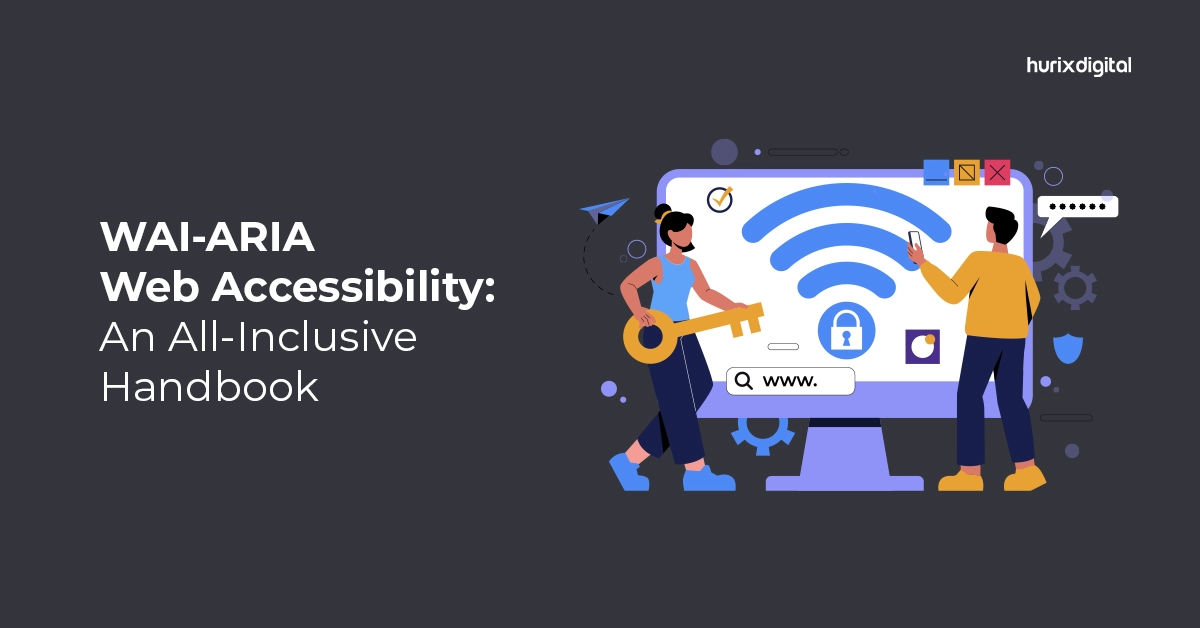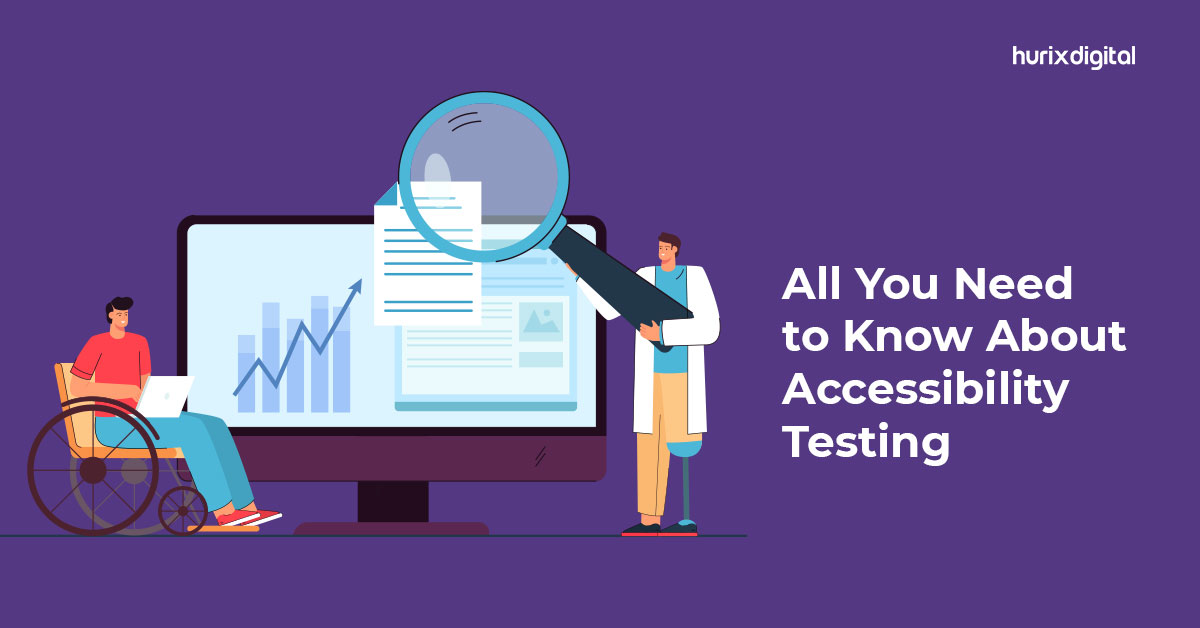
WAI-ARIA Web Accessibility: An All-Inclusive Handbook
Summarize with:
The internet has developed so quickly that digital accessibility is now a top concern. Nearly all of us now get our information from the web, and it is essential that everyone can view and interact with digital material.
To account for this inclusion, the World Wide Web Consortium (W3C) created the Web Accessibility Initiative—Accessible Rich Internet Applications (WAI-ARIA).
In this article, we will explore ARIA and examine how it improves accessibility for different user groups.
Table of Contents:
- Understanding Web Accessibility
- The Role of WAI-ARIA
- ARIA Roles: Improving Interaction
- Practical Application of ARIA
- ARIA: Enhancing the User Experience
- The Future of ARIA and Web Accessibility
- Final Words
Understanding Web Accessibility
Web accessibility is the process of removing barriers to online contact for users with disabilities. Everybody can access content and features on well-designed websites equally. This includes many neurological, learning, vision, hearing, and physical impairments.
Making online material readable by people with varying abilities is known as digital accessibility. Web developers can create accessible websites that comply with the ADA (Americans with Disabilities Act).
The Role of WAI-ARIA
WAI-ARIA provides a means of improving the accessibility of online applications and information for people with impairments. It especially helps to improve the accessibility of screen readers and other assistive technology, which could make it difficult to understand complex interfaces or dynamic information.
The exact technical definition of WAI-ARIA provides an organized framework for adding accessibility information to web applications. Improved accessibility to interactive content, such as menus and other user interfaces, that is difficult to understand with standard HTML is particularly advantageous.
WAI-ARIA’s three basic components are roles, states, and properties. These capabilities can be included in HTML tags to provide assistive technology with additional context, improving the accessibility of web applications. The specification guarantees the maximum degree of accessibility benefits by providing guidelines for ARIA syntax and its appropriate deployment.
Also Read: Exploring the Realm of Accessibility in 2024
ARIA Roles: Improving Interaction
Within WAI-ARIA, roles provide a specific type of user interface element. Giving website components ARIA roles lets programmers explain to assistive technology the function and behavior of certain components.
Thanks to screen readers and other assistive devices that enable navigation and engagement, people with impairments can access web material more easily.
Below are a few frequently used ARIA roles and their respective purposes:
- Role=”button”: Applied to elements that act as buttons. This is especially useful for divs or spans styled as buttons.
- Role=”navigation”: Designates a section of the page intended for navigation.
- Role=”banner”: Marks the site-wide banner area, typically containing the logo and main heading.
- Role=”main”: Indicates the main content area of a page.
- Role=”complementary”: Used for content that complements the main content, such as a sidebar.
- Role=”dialog”: Defines a dialog box or window.
Practical Application of ARIA
Integrating ARIA into web development requires a methodical strategy to ensure that it improves accessibility without creating additional obstacles.
Below are several recommended strategies for implementing ARIA:
1. Use ARIA Only When Necessary
Although ARIA can significantly enhance accessibility, it should not be employed to supersede or substitute native HTML components.
Native HTML components possess inherent accessibility characteristics that are frequently more comprehensive than their ARIA equivalents. Use semantic HTML tags such as and whenever possible, rather than relying on ARIA responsibilities.
2. Ensure Keyboard Accessibility
Web accessibility relies heavily on the inclusion of keyboard accessibility. Those who are unable to use a mouse rely mostly on keyboard navigation to connect with online content.
It is critical to use ARIA roles and characteristics so that interactive components can be accessed with a keyboard. This means using keyboard event handlers to mimic mouse actions and implementing appropriate attention management.
3. Test with Assistive Technologies
How well ARIA is implemented depends on how well assistive technologies like screen readers (e.g., JAWS, NVDA, VoiceOver) are tested with web material. Testing ensures that ARIA roles and features are interpreted correctly and is required to identify any flaws that might not be immediately obvious from a visual inspection alone.
ARIA: Enhancing the User Experience
Apart from satisfying legal obligations, WAI-ARIA enhances the user experience generally by enabling universal navigation and understanding of digital content.
ARIA greatly enhances accessibility in the following situations:
1. Dynamic Content Updates
Material in modern web apps is sometimes dynamically modified without requiring a full page reload.
Because they do not automatically alert users to the changes, these adjustments can be difficult for screen readers. ARIA live regions, such as aria-live=”polite,” allow developers to alert screen readers to fresh content by notifying them of updates.
2. Form Validation
Users cannot understand and fix input errors without form validation notifications. However, incorrect implementation could prevent screen readers from identifying these signals.
By connecting error messages with the pertinent form fields, developers can improve the user experience by using ARIA features like aria-invalid and ARIA-described. Users may now more easily find and fix errors.
The Future of ARIA and Web Accessibility
The need for digital accessibility will unavoidably grow as the internet develops. The WAI-ARIA standard is continuously updated by the World Wide Web Consortium (W3C) to address new challenges and investigate potential in web development.
Web developers and designers need to stay updated on the most recent accessibility standards and optimal methods.
Professionals can stay updated with industry changes by engaging in accessibility training, attending conferences, and joining online forums. In addition, working with users who have disabilities can offer useful perspectives on practical accessibility obstacles and remedies.
The ultimate goal of ARIA and online accessibility is to set up a complete digital environment that allows everyone to participate fully. This requires a shift of viewpoint, emphasizing accessibility from the outset of each project instead of treating it as an afterthought.
Also Read: All You Need to Know about the European Accessibility Act 2025 and WCAG
Final Words
WAI-ARIA is a vital tool for the future of web accessibility. Developers who grasp and use ARIA roles, states, and characteristics can improve assistive technology functionality and the user experience.
Developing an accessible internet is a part we must all play, and at Hurix Digital, we recognize the significance of a user-friendly online representation. Our specialists excel at incorporating web accessibility functionalities to deliver an exceptional user experience for all individuals.
Contact us now and increase your online visibility immediately!
Summarize with:

Vice President – Content Transformation at HurixDigital, based in Chennai. With nearly 20 years in digital content, he leads large-scale transformation and accessibility initiatives. A frequent presenter (e.g., London Book Fair 2025), Gokulnath drives AI-powered publishing solutions and inclusive content strategies for global clients
 Upcoming Masterclass | Build an Army of Brand Evangelists using Training & Development | November 20th, 8:30 AM PDT | 11:30 AM EDT | 10:00 PM IST
Upcoming Masterclass | Build an Army of Brand Evangelists using Training & Development | November 20th, 8:30 AM PDT | 11:30 AM EDT | 10:00 PM IST




